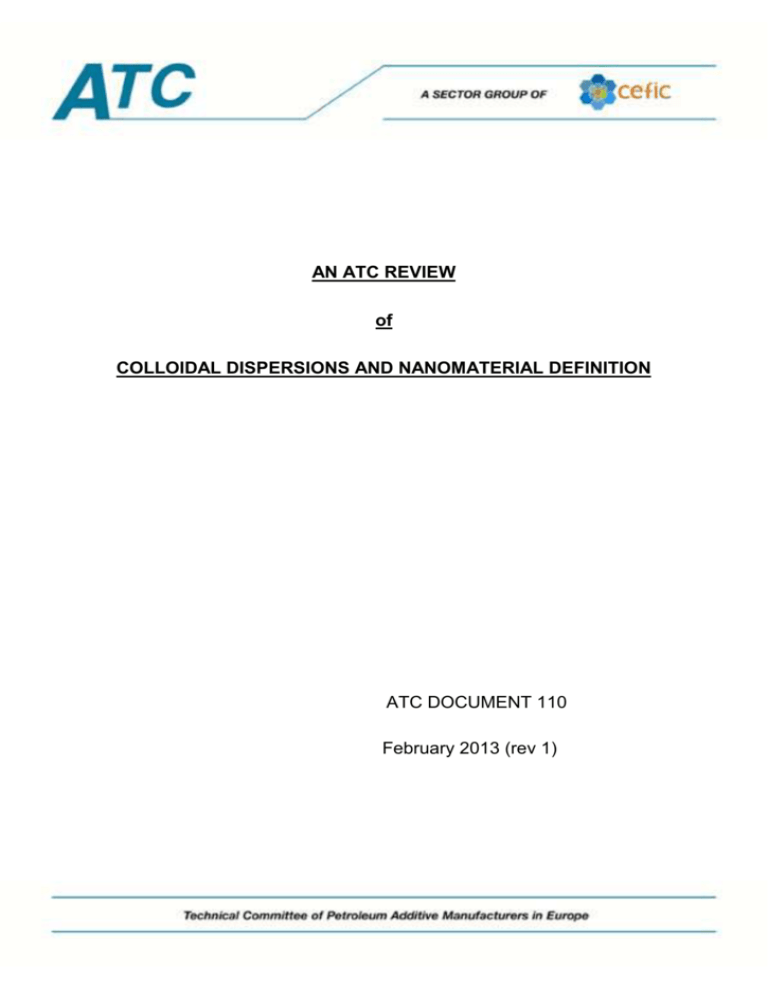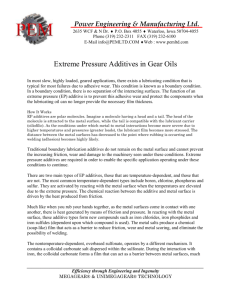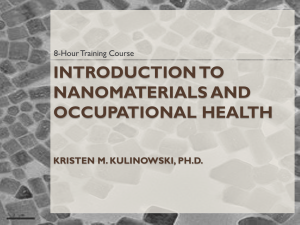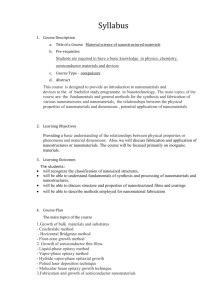atc document 110
advertisement

AN ATC REVIEW of COLLOIDAL DISPERSIONS AND NANOMATERIAL DEFINITION ATC DOCUMENT 110 February 2013 (rev 1) Overbased Additives and Other Similar Lubricating Oil Additives Summary ATC do not consider overbased lubricant additives to be “nanomaterials” within the Commission Recommendation of 18 October 2011 on the definition of a nanomaterial (2011/696/EU) (i). This is because they are non-particular materials existing as a micellar system wherein the metal carbonate core “particles” are part of and entirely dependent on the micellar system and cannot be isolated as particles. They do not exist as unbound particles from which the nano form can be released under any conditions of use. Background On 18 October 2011 the European Commission adopted the Recommendation on the definition of a nanomaterial (i). According to this Recommendation a "Nanomaterial" means: “A natural, incidental or manufactured material containing particles, in an unbound state or as an aggregate or as an agglomerate and where, for 50 % or more of the particles in the number size distribution, one or more external dimensions is in the size range 1 nm - 100 nm. In specific cases and where warranted by concerns for the environment, health, safety or competitiveness the number size distribution threshold of 50 % may be replaced by a threshold between 1 and 50 %. By derogation from the above, fullerenes, graphene flakes and single wall carbon nanotubes with one or more external dimensions below 1 nm should be considered as nanomaterials.” It is the view of the Commission that whilst nanomaterials are not intrinsically hazardous, there is still uncertainty about the safety of nanomaterials and therefore the safety assessment of these substances needs to be done on a case by case basis. It is the stated intention of the Commission that the definition above will provide clear and unambiguous criteria to identify such materials and that it will be used in subsequent legislation. Further clarification of the definition is provided in a question and answer paper contained in the following link. http://ec.europa.eu/environment/chemicals/nanotech/index.htm (ii) Based on the above background, this document is the ATC response considering whether colloidal dispersions, in particular the overbased additives, should be considered to be nanomaterials as defined by the Commission. Use of Colloidal Dispersions in Lubricating Oils The use of colloidal dispersions as additives in lubricating oils has a long history. Their first use, as overbased sulphonates, is thought to have been in the 1940s with the first use in commercial vehicles in the 1950s (iii)(iv). These dispersions, often known within the lubricant additive industry as overbased additives, have been characterised as having cores of Group I or Group II metal carbonate and/or hydroxide stabilised by a layer of surfactant. The dispersion is formed in situ by reaction of a metal hydroxide or oxide with carbon dioxide in the presence of the stabilising surfactant. The resulting product is a clear, thermodynamically stable fluid dispersion in a hydrocarbon medium. The diameter of several overbased additives has been measured by small angle neutron scattering and is typically in the range 8 to 20 nm (v). Discussion Colloids are typically defined as having at least one linear dimension approximately between 1 nanometer and 1 micron. So if considering only size, colloidal dispersions regardless of the composition of the phases (solid, liquid or gas) would fall within the Commission definition provided the size fell at the lower end of the range (< 100nm). In the Commission’s technical information to support the recommendation (i) it is stated that: “the Commission definition of “nanomaterial” is limited to materials consisting of particles (excluding non-particular materials such as proteins or micelles as present for example in mayonnaise)”. Further, it clarifies that the “the Recommendation only concerns particulate nanomaterials”. A particle is defined (i) as “a minute piece of matter with defined physical boundaries”. Matter is commonly understood to be any substance which has mass and can exist in various phases: solid, liquid, gas or plasma. Mayonnaise is a classic example of a colloidal dispersion known as an emulsion or micro-emulsion where two liquid phases are separated by a layer of surfactant. A micelle or micro-emulsion has mass and defined physical boundaries, e.g. its size can be measured. However, the guidance document states that such a system does not fall within the definition. Micelles are noted in the answer to Q3 of the Commission Questions and Answers supporting document as an example of “non-particular materials” to which the definition does not apply. Since, as noted by the European Commission-Joint Research Centre (v) particles may be liquid it may be inferred that the exclusion of micelles from the definition is based on the fact that micelles are a manifestation of the assembly of surfactant molecules within a liquid dispersion medium and can exist only in this form; a micelle cannot be isolated as a particle. In the same way that micelles cannot be isolated, the metal carbonate core of an overbased additive micelle cannot be isolated as a particle. The metal carbonate is synthesised in situ by reaction of a metal hydroxide or oxide with carbon dioxide in the presence of the stabilising surfactant. The metal carbonate exists in this form only within the micelles of the colloid. Attempts to isolate the core material result in precipitation of the metal carbonate as coarse sediment. In summary, the structure of an overbased additive is a micellar system with a surfactant layer dispersing the core material. Such systems are excluded from the scope of the definition. The metal carbonate core of the overbased additive is part of and entirely dependent on this micellar system. On this basis overbased additives do not fall within the definition of a nanomaterial according to the EU Commission Recommendation. (i) Commission Recommendation of 18 October 2011 on the definition of a nanomaterial (2011/696/EU), http://eurlex.europa.eu/LexUriServ/LexUriServ.do?uri=OJ:L:2011:275:0038:0040:EN:PDF (ii) http://ec.europa.eu/environment/chemicals/nanotech/index.htm (iii) Chemistry & Technology of Lubricants, Eds. R. M. Mortier & S. T. Orszulik Blackie, (London), 1992 (iv) Automotive Lubricant Reference Book, A. Caines and R. Hancock, SAE, 1996 (v) EC-JRC (2010) Considerations on a Definition of Nanomaterial for Regulatory Purposes. JRC Reference Reports http://ihcp.jrc.ec.europa.eu/our_activities/nanotechnology/report-definition-nanomaterial Further information: Markovic, I.; Ottewill, R. H.; Cebula, D. J.; Field, I.; Marsh, J. F. Colloid and Polymer Science (1984), 262(8), 648-56








